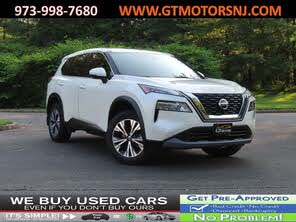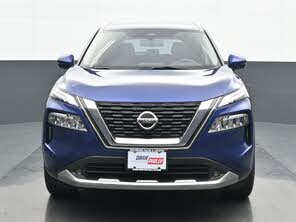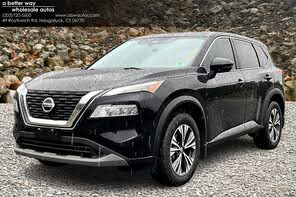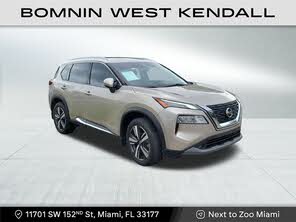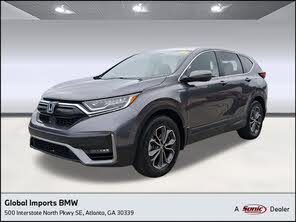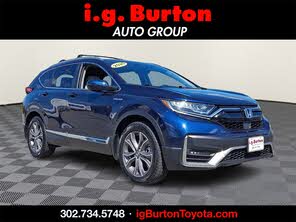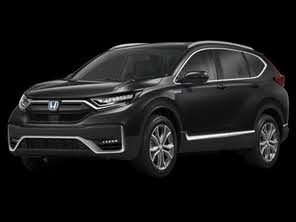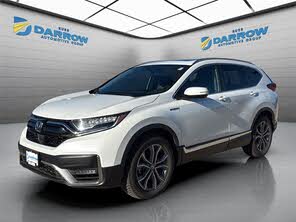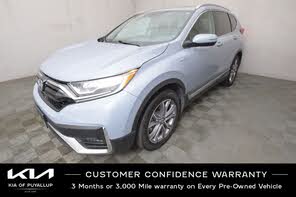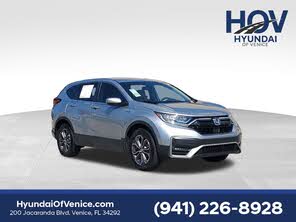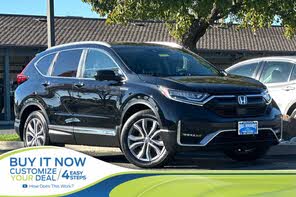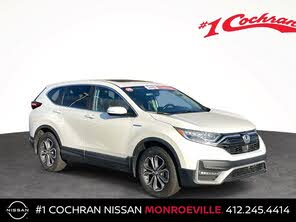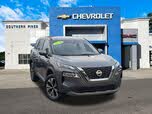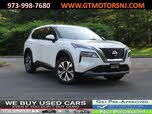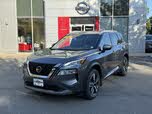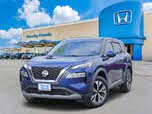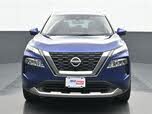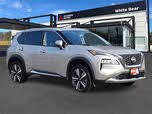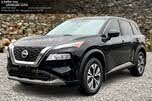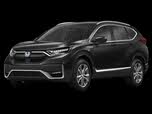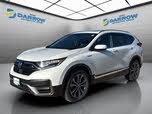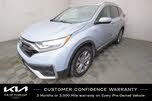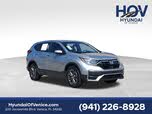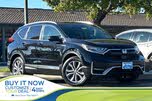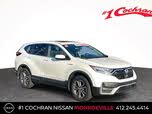2021 Nissan Rogue vs 2020 Honda CR-V Hybrid
Overview | |
MSRP$27,850 | MSRP$26,050 |
Listings217 | Listings2468 |
Ratings & Reviews | |
User Reviews | User Reviews |
Expert reviews7.3 out of 10 | Expert reviews9.0 out of 10 |
Pros
Cons
| Pros
Cons
|
2020 Honda CR-V Hybrid Reviews SummaryOne of the forerunners to today’s seemingly never-ending onslaught of crossover SUV debuts, the Honda CR-V entered the market when SUV meant body-on-frame truck and CUV meant, well, nothing. The year was 1996 and the only other crossover option in the U.S. was the Toyota RAV4, which went on sale the year prior. Since then, hybrid technology has become commonplace. Yet, Americans have lived without a battery-assisted Honda crossover. That finally changes, with the debut of the 2020 Honda CR-V Hybrid. | |
2021 Nissan Rogue Reviews SummaryTo characterize the all-new 2021 Nissan Rogue as vital to the automaker's success is an understatement. Not only is the compact crossover SUV the best-selling Nissan in America, but it's also one of the best-selling vehicles in America. Strip out pickup trucks, and the Rogue sits near the top of the U.S. sales chart with its primary competitors, the Honda CR-V and Toyota RAV4. Imagine the pressure on Nissan designers, engineers, and product planners as they prepared the current Rogue's replacement! The good news is that the new Rogue is a better SUV in every way but one. | |
No video found | |
Popular Features & Specs | |
Engine2.0L 212 hp I4 Hybrid | Engine2.5L 181 hp I4 |
Drive TrainAWD | Drive TrainFWD |
Seating Capacity5 | Seating Capacity5 |
Horsepower212 hp @ 6200 rpm | Horsepower181 hp @ 6000 rpm |
EV Battery Capacity1.3 kWh | EV Battery Capacity |
MPG City40 | MPG City27 |
MPG Highway35 | MPG Highway35 |
Engine | |
Engine Name2.0L 212 hp I4 Hybrid | Engine Name2.5L 181 hp I4 |
Torque | Torque181 lb-ft @ 3600 rpm |
Horsepower212 hp @ 6200 rpm | Horsepower181 hp @ 6000 rpm |
DrivetrainAWD | DrivetrainFWD |
Fuel Economy | |
EV Battery Capacity1.3 kWh | EV Battery Capacity |
MPG City40 | MPG City27 |
MPG Highway35 | MPG Highway35 |
Interior | |
Seating Capacity5 | Seating Capacity5 |
Safety | |
Front Crash Overall5 | Front Crash Overall3 |
Side Crash Overall5 | Side Crash Overall5 |
Dimensions & Capacity | |
Cargo Space33.2 cu ft | Cargo Space31.6 cu ft |
Curb Weight3649 lbs | Curb Weight3371 lbs |
Height66.5 in | Height66.5 in |
Length182.1 in | Length183.0 in |
Width73.0 in | Width72.4 in |
Wheelbase104.7 in | Wheelbase106.5 in |
Maximum Payload | Maximum Payload1115 lbs |
Number of doors4 | Number of doors4 |
Overview | ||
MSRP | $27,850 | $26,050 |
Listings | ||
Ratings & Reviews | ||
User reviews | ||
Expert reviews | 7.3 out of 10Read full review | 9.0 out of 10Read full review |
Pros & cons | Pros
Cons
| Pros
Cons
|
Summary | One of the forerunners to today’s seemingly never-ending onslaught of crossover SUV debuts, the Honda CR-V entered the market when SUV meant body-on-frame truck and CUV meant, well, nothing. The year was 1996 and the only other crossover option in the U.S. was the Toyota RAV4, which went on sale the year prior. Since then, hybrid technology has become commonplace. Yet, Americans have lived without a battery-assisted Honda crossover. That finally changes, with the debut of the 2020 Honda CR-V Hybrid. | To characterize the all-new 2021 Nissan Rogue as vital to the automaker's success is an understatement. Not only is the compact crossover SUV the best-selling Nissan in America, but it's also one of the best-selling vehicles in America. Strip out pickup trucks, and the Rogue sits near the top of the U.S. sales chart with its primary competitors, the Honda CR-V and Toyota RAV4. Imagine the pressure on Nissan designers, engineers, and product planners as they prepared the current Rogue's replacement! The good news is that the new Rogue is a better SUV in every way but one. |
Video | No video found | |
Popular Features & Specs | ||
Engine | 2.0L 212 hp I4 Hybrid | 2.5L 181 hp I4 |
Drive Train | AWD | FWD |
Seating Capacity | 5 | 5 |
Horsepower | 212 hp @ 6200 rpm | 181 hp @ 6000 rpm |
EV Battery Capacity | 1.3 kWh | |
MPG City | 40 | 27 |
MPG Highway | 35 | 35 |
Engine | ||
Engine Name | 2.0L 212 hp I4 Hybrid | 2.5L 181 hp I4 |
Torque | 181 lb-ft @ 3600 rpm | |
Horsepower | 212 hp @ 6200 rpm | 181 hp @ 6000 rpm |
Drivetrain | AWD | FWD |
Fuel Economy | ||
EV Battery Capacity | 1.3 kWh | |
MPG City | 40 | 27 |
MPG Highway | 35 | 35 |
Interior | ||
Seating Capacity | 5 | 5 |
Safety | ||
Front Crash Overall | 5 | 3 |
Side Crash Overall | 5 | 5 |
Dimensions & Capacity | ||
Cargo Space | 33.2 cu ft | 31.6 cu ft |
Curb Weight | 3649 lbs | 3371 lbs |
Height | 66.5 in | 66.5 in |
Length | 182.1 in | 183.0 in |
Width | 73.0 in | 72.4 in |
Wheelbase | 104.7 in | 106.5 in |
Maximum Payload | 1115 lbs | |
Number of doors | 4 | 4 |
The 2020 Honda CR-V Hybrid, having undergone a mid-cycle refresh since being all-new in 2017, visually mirrored its gasoline-powered version. This hybrid's dimensions were identical to its gasoline counterpart, marked by specific measurements like a length of 182.1 inches, width of 73.0 inches, and height of 66.5 inches. Even the 19-inch alloy wheel pattern on the Touring trim was unchanged. Inside, the cabin looked virtually the same, featuring the same dashboard design and multi-function center console, along with a 7-inch infotainment screen, steering-wheel-mounted controls, and the driver information panel.
However, the differences, though subtle, were present. Exclusive to the hybrid were blue-outlined Honda emblems and “Hybrid” badges on the A-pillars and tailgate. A hidden exhaust below the rear lower bumper also added a touch of distinction, along with EX models and above featuring LED fog lights, absent in gasoline versions.
Internally, notable changes included a push-button gear selector replacing the traditional shifter, a design feature aligned with other Honda hybrids like the Accord and Insight. Paddle shifters were repurposed to adjust brake regeneration aggressiveness. The instrument panel remained but now displayed driving modes—Normal, EV, Econ, and Sport.
For the 2021 Nissan Rogue, the model boasted a handsome new styling, displaying a more technical appearance making it resemble an SUV. Dark gray plastic cladding covered its lower perimeter, accompanied by bold, simulated skid plates and lower door protection, which gave it a rugged look. Clean LED lighting, a prominent V-Motion grille, and proper proportioning added to the modern aesthetic. All trim levels had aluminum wheels, up to 19 inches in diameter. Optional two-tone paint with a black roof treatment gave it a custom flair.
The Rogue came in four versions: the entry-level Rogue S, the popular Rogue SV, the slightly luxurious Rogue SL, and the new-for-2021 Rogue Platinum brimming with semi-aniline quilted leather and other upscale amenities. With all-wheel drive costing extra and the Premium option packages available for the SV and SL trims, our tested Rogue SL, complete with these packages and extra paint, totalled $35,195.
Inside, the test vehicle's Almond color leather interior with a standard panoramic glass sunroof enhanced the sense of roominess. Nissan emphasized quality with abundant soft-touch surfaces, appealing simulated wood trim, and fabric-wrapped windshield pillars. Rear-seat accommodation was improved with more generous head- and legroom, and rear doors opening to nearly 90 degrees for easier loading. Platinum trim added even more luxury with quilted semi-aniline leather, contrast stitching, and ambient lighting.











The 2020 Honda CR-V Hybrid came equipped with all-wheel drive (AWD) and a two-motor hybrid system combining a 2.0-liter 4-cylinder gasoline engine with an electric generator/starter motor and a propulsion motor. This setup eliminated the need for a conventional automatic or continuously variable transmission, instead opting for four fixed-ratio gear sets and a lock-up clutch.
Total system output was 212 horsepower and 232 pound-feet of torque, compared to the gasoline model's 190 horsepower and 179 pound-feet of torque. The hybrid's fuel economy stood at an impressive 40 mpg city, 35 highway, and 38 combined. Comparatively, the gasoline AWD model delivered 27/32/29 mpg.
In driving, the CR-V Hybrid displayed nearly 41 mpg in city conditions, while the hybrid drivetrain provided notable on-demand torque, making it more enjoyable to drive than its gasoline counterpart. The CR-V Hybrid was compliant on various road conditions, with AWD engaging as necessary. However, it ranked third in fuel economy among competitor hybrids like the Ford Escape and Toyota RAV4.
Conversely, the 2021 Nissan Rogue lacked power with its single engine option: a direct-injected 2.5-liter four-cylinder producing 181 horsepower and 181 pound-feet of torque. Given its weight of nearly 3,500 pounds, the engine output was adequate for daily driving but left more to be desired for adventurous driving, especially in mountainous terrains. The CVT managed the available torque well, resembling a traditional automatic in feel and responsiveness.
With available AWD, up to 8.2 inches of ground clearance, and new Snow and Off-Road driving modes, the Rogue could venture off-road partially but felt underpowered. Fuel economy for the front-wheel drive (FWD) model was 27.5 mpg on varied roads, slightly below its EPA rating.
While the Rogue handled smoothly and predictably due to a strut front and multi-link rear suspension system, its steering improvements were noteworthy. Moving from the steering column to the steering rack and quickening the ratio resulted in better steering feedback, enhancing overall driving experience.
The 2020 Honda CR-V Hybrid, while identical in dimensions to the gasoline version, saw a compromise in cargo capacity due to the battery pack. Offering 33.2 cubic feet behind the rear seats and up to 68.7 cubic feet when folded flat, it lagged behind the non-hybrid's 39.2 and 75.8 cubic feet, respectively. However, it still surpassed the Ford Escape Hybrid. The Toyota RAV4 Hybrid had more cargo space with 37.6 cubic feet behind the seats and 69.8 cubic feet when folded down.
The CR-V Hybrid maintained passenger comfort by offering more overall space than the Ford and Toyota hybrids, including superior front headroom and rear legroom. The center console bin's configurability provided additional storage, although the armrest's too-eager adjustability was a minor drawback.
Nissan's 2021 Rogue featured Zero Gravity seat designs, aiming to replicate a neutral spine position for enhanced comfort. The seats varied across trims, with the base S using cloth and manual adjustments, while higher trims like SV had leatherette or leather options. Heated seats and steering wheel were available on higher trims, but ventilated seats were not offered.
The Rogue added more generous rear-seat headroom and legroom compared to previous models. Rear doors opening to nearly 90 degrees eased passenger loading. An improved interior noise reduction and a comprehensive storage solution, including a new electronic shifter freeing up space under the center console, enhanced practicality. Cargo capacity varied with trims, from 31.6 cubic feet in S and SV to 36.5 cubic feet in SL and Platinum, thanks to a Divide-N-Hide system. Folding the rear seats expanded it to 74.1 cubic feet, among the largest in the segment.
The 2020 Honda CR-V Hybrid came with standard tech like Bluetooth, Pandora compatibility, and a single USB connector. Higher trims added more features, starting with the EX trim's 7-inch touchscreen display, Honda Link, smartphone integration, and a 180-watt stereo system. Touring trim offered navigation, wireless charging, and a 330-watt audio system. However, the interface required navigating through several menus often, leading to potential frustration.
The 2021 Nissan Rogue offered a competitive infotainment system. The base S trim featured an 8-inch touchscreen with Bluetooth, SiriusXM, Apple CarPlay, and Android Auto. The SV and SL trims added Nissan Connect Services, WiFi hotspot, and integration with voice assistants like Alexa and Google. Higher trims, including the SL Premium Package and Platinum, had a larger 9-inch touchscreen, navigation, wireless Apple CarPlay, and Bose audio system. The Platinum trim featured even more advanced tech with wireless charging, a digital instrument cluster, and a head-up display.
The 2020 Honda CR-V Hybrid boasted a Top Safety Pick from IIHS and a 5-Star Safety Rating from NHTSA. Standard Honda Sensing included features like automatic braking, forward-collision warning, lane-departure warning, lane-keep assist, adaptive cruise control, and a multi-angle rearview camera. Blind-spot monitoring and rear cross-traffic alert were available starting with the EX trim.
The 2021 Nissan Rogue placed a high emphasis on safety with its comprehensive Safety Shield 360 suite, including features like automatic braking with pedestrian detection, lane-departure warning, and blind-spot warning. Unlike many competitors, blind-spot monitoring was standard from the base trim. Models from the SV trim upward included ProPilot Assist with adaptive cruise control and lane-centering. Higher trims featured upgraded ProPilot Assist with Navi-link technology for enhanced driving assistance. The use of high-strength steel and other engineering improvements suggested a robust crash protection capability.
CarGurus highlights
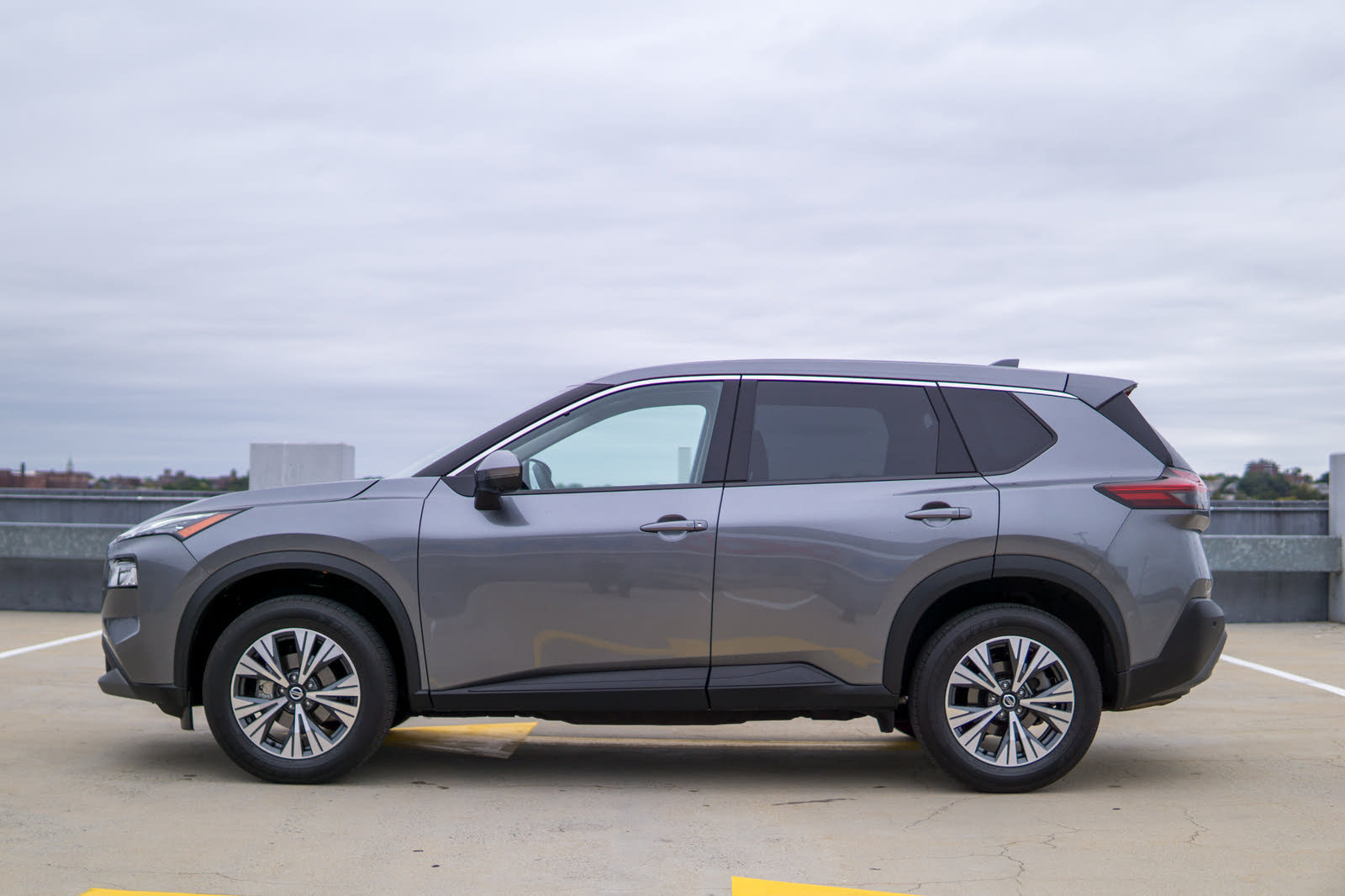
According to CarGurus experts, the overall rating for the 2020 Honda CR-V Hybrid was 7.3 out of 10, while the 2021 Nissan Rogue scored 9.0 out of 10. With its higher rating, the 2021 Nissan Rogue emerges as the more recommendable option, offering a better blend of modern styling, advanced technology, and comprehensive safety features.
Choose the 2021 Nissan Rogue if:
- You prefer an SUV with modern, rugged styling and premium interior options.
- You want a comprehensive infotainment system with advanced features and voice assistant integration.
- You need more safety features, including blind-spot monitoring as standard on the base model.
Choose the 2020 Honda CR-V Hybrid if:
- You prioritize fuel efficiency with a hybrid powertrain.
- You value a more spacious and configurable interior for both passengers and cargo.
- You appreciate standard safety features and top-tier safety ratings.
CarGurus highlights

According to CarGurus experts, the overall rating for the 2020 Honda CR-V Hybrid was 7.3 out of 10, while the 2021 Nissan Rogue scored 9.0 out of 10. With its higher rating, the 2021 Nissan Rogue emerges as the more recommendable option, offering a better blend of modern styling, advanced technology, and comprehensive safety features.
Choose the 2021 Nissan Rogue if:
Shop Now- You prefer an SUV with modern, rugged styling and premium interior options.
- You want a comprehensive infotainment system with advanced features and voice assistant integration.
- You need more safety features, including blind-spot monitoring as standard on the base model.
Choose the 2020 Honda CR-V Hybrid if:
Shop Now- You prioritize fuel efficiency with a hybrid powertrain.
- You value a more spacious and configurable interior for both passengers and cargo.
- You appreciate standard safety features and top-tier safety ratings.

By: CarGurus + AI
At CarGurus, our team of experienced automotive writers remain at the heart of our content operation, conducting hands-on car tests and writing insightful guides that are backed by years of industry experience. To complement this, we are harnessing AI to make our content offering more diverse and more helpful to shoppers than ever. To achieve this, our AI systems are based exclusively on CarGurus content, ratings and data, so that what we produce is both unique to CarGurus, and uniquely helpful to car shoppers.




